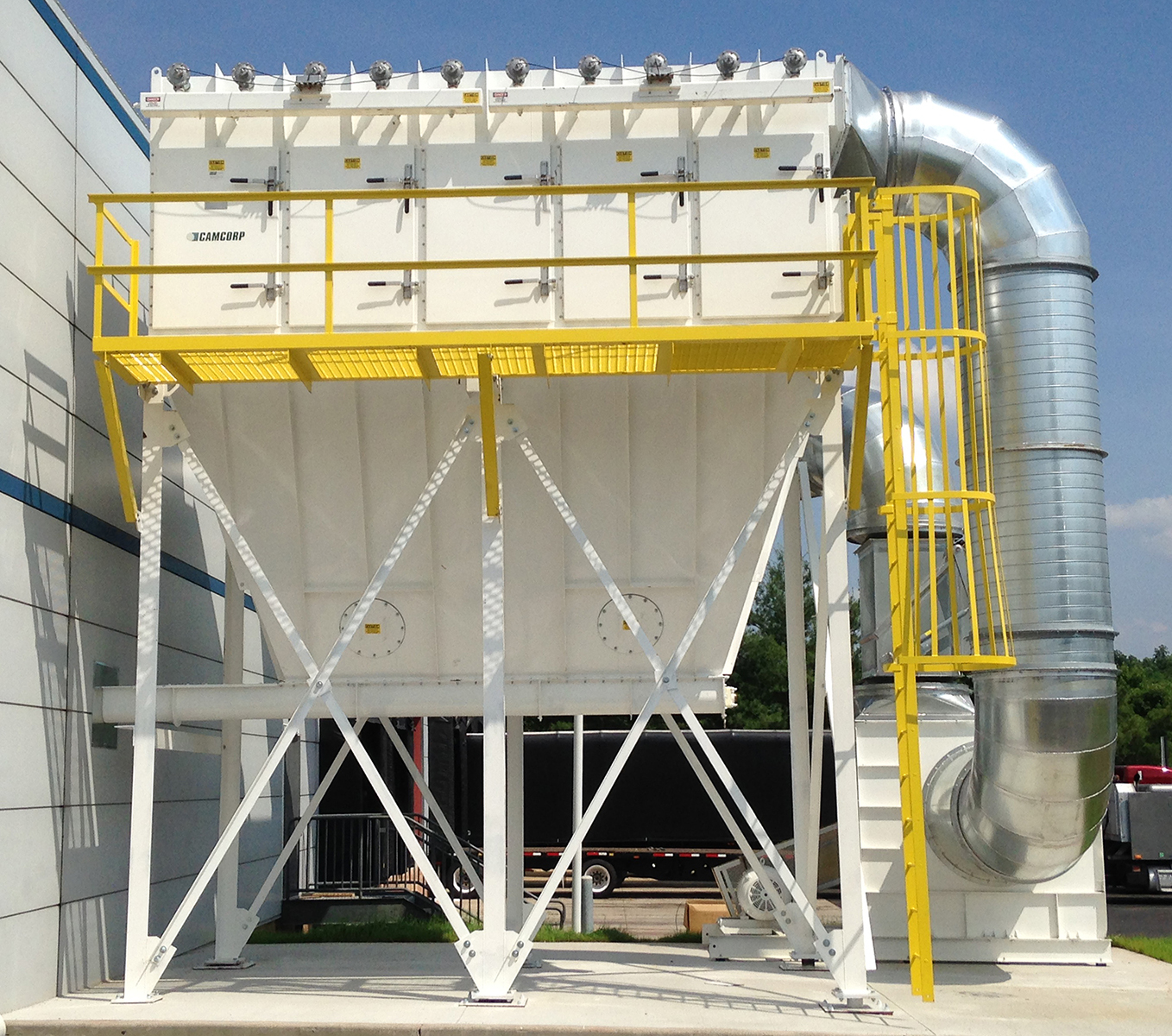
For businesses that manufacture or convert paper, or work with grains, powders, or agricultural and food products, combustible dusts are nothing to sneeze at. Dust can be one of the biggest health, safety, and productivity risks for companies across a wide variety of industries. Manufacturers in industries such as corrugated box and folding carton, printing and converting, grain and foodstuffs processing, and bulk handling and filling operations all generate a significant amount of dust as a byproduct.
Dust is much more than a housekeeping problem. Airborne dusts, as well as accumulated dusts on walls, floors, support structures and equipment, can be a fire hazard, posing a significant risk to life and safety. Dust is an eye and lung irritant that can exacerbate employee allergies and asthma, and some dusts have toxic or carcinogenic properties. Over time, equipment functionality can be affected by dust infiltration, affecting service life and productivity.
A robust industrial dust collection system can mitigate the many dangers associated with combustible dusts and help organizations remain compliant with NFPA (National Fire Protection Agency) and OSHA (Occupational Safety and Health Administration) standards.
The Function of an Industrial Dust Collector
Industrial dust collectors and other types of air/material separators are designed to use static pressure to filter fine particulate from the air. They are commonly utilized in industrial manufacturing facilities such as printing and paper converting, box and folding carton, woodworking, agricultural and foodstuff processing, milling and mining, pharmaceuticals, plastics and film processing, and bulk filling operations.
Industrial dust collectors and associated dust removal and filtration equipment prevent airborne particles from accumulating on solid surfaces in the plant. By capturing and filtering dust particles, dust collectors are an effective means of protection for employees and the physical plant from the dangers of a dust explosion or fire.
The Hazards of Dust in the Manufacturing Environment
Fire and explosion are the biggest risks posed by dust in manufacturing facilities. Even small accumulations of dust on surfaces can pose a substantial risk of fire. Accumulated dusts of 1/32” in the work environment are considered hazardous by both OSHA and NFPA. If combustible in nature, dust can pose a serious threat to life and safety. A simple spark introduced in a closed environment can set off a chain reaction of explosion and fire. The precedent for dust regulations can be traced to incidents like the 2008 explosion at Imperial Sugar in Georgia, a catastrophic event that resulted in a tragic loss of life and the total destruction of the plant. As a result, OSHA created the National Emphasis Program for Combustible Dust (NEP), a rigorous set of conditions and compliance rules designed to prevent similar catastrophes at facilities that produce combustible dusts. OSHA takes the risk of dust very seriously, and non-compliant facilities risk receiving hefty fines or even entire plant shutdowns for violations.
The Impact of Dust on Workplace Health & Safety
The effect of dust on the well-being and safety of manufacturing employees is an obvious one. Working in a facility contaminated by dust and other forms of debris—whether in the air or layered on top of nearby equipment—can create serious health risks, potentially causing damage to the lungs of those who breathe in harmful, unseen materials. It goes without saying that when indoor air quality is poor, the health of employees suffers, which can also lead to unhappy team members and high turnover.
The Impact of Dust on Workplace Productivity
The collection of dirt and dust on manufacturing equipment can significantly impact workplace productivity in more ways than one. When left unchecked, debris can begin to enter equipment and interfere with their mechanics, stalling both automated and manual processes and even negatively affecting the quality of finished products.
The most extreme disruption to productivity from dust accumulation is a fire. Dust poses a great fire hazard, as friction and static electricity can lead to sparks that may ignite and result in deadly flames and explosions. Industrial dust collection systems that contain explosion control equipment can keep all of this under control. NFPA 68, the Standard on Explosive Protection by Deflagration Venting, requires companies producing combustible dusts to maintain this special equipment, comply with inspections, and establish intelligent remediation plans to proactively combat hazardous dust-related events. Fire suppression and spark detection systems are also used in combination with dust control measures to ensure full compliance with prevailing NFPA standards.

Selecting the Right Industrial Dust Collector
Dust collection systems come in several types and sizes, including baghouse dust collectors, cartridge dust collectors, industrial HEPA filters, and enclosureless dust collectors. Determining the type and size of dust collector to be used depends on many factors and starts with a three-step process as outlined below.
1)The first step is to perform a dust hazard analysis or dust test. A dust sample is tested by a specialty lab to determine if it contains explosive properties. Dusts are classified by types and rated for certain values, such as KST, a dust deflagration index that measures explosive pressure. Explosive dusts are classified and rated by the NFPA, with each type subject to specific explosion protection standards. If the dust is found to be explosive in nature, it will fall under the jurisdiction of requirements from OSHA’s National Emphasis Program (NEP). The NEP sets policies and procedures for the inspection of facilities that generate or handle combustible dusts which pose a hazard of fire or deflagration. Note that non-explosive dusts may still require a dust collection system, but they will not be subject to the OSHA compliance standards.
2) Once the properties of the dust are established, a written Risk Assessment Plan must be developed, as per NFPA 654. Plan basics include but are not limited to identifying the materials that may form the dust and the possible ignition sources, identifying the at-risk personnel and the ways they may be harmed, developing a communications plan and training for employees, and a plan for risk reduction through preventive and protective measures.
3) Armed with the information from steps 1 and 2, the next action is to begin implementation of the plan, including the selection of appropriate dust control equipment. As previously discussed, there are many factors that go into selecting the right collector for the job, including type and combustibility of dust, volume, KST value, the number of dust-producing machines in the facility, and the collection and conveyance methods employed. Some systems will require spark and flame detection and extinguishing systems, as others will need specialized explosion venting. Given the potential risks and number of variables involved, it is important to work with an expert provider of dust collection systems to ensure you get the proper type and size collector for your application. Keep in mind that these dust systems will need to be cleaned and maintained periodically, so choose a vendor that can provide a turnkey program for the life of the system.
Ensuring Compliant Dust Control
Industrial dust collectors and high-functioning dust collection systems are essential for meeting regulation requirements, keeping employees safe, and running smooth, sustainable operations. With AES’s line of dust collection and fire and explosion protection solutions, organizations can stay compliant and operate with a higher degree of safety as they respond to changing industry standards and enforcement guidelines. As a single source for conveyance needs, AES engineers custom scrap and dust systems and works as a partner in process improvement to help businesses achieve greater profitability, productivity, and sustainability in their operations. More information on dust collectors and AES dust control solutions can be found on our website.
Get in touch with the AES team to learn more about effective dust control and our suite of value-added services.
